Italian actor Angelo Ferrari (1897-1945) appeared in nearly 200 films. He started his career in Italian silent films and later got a strong foothold in German cinema.
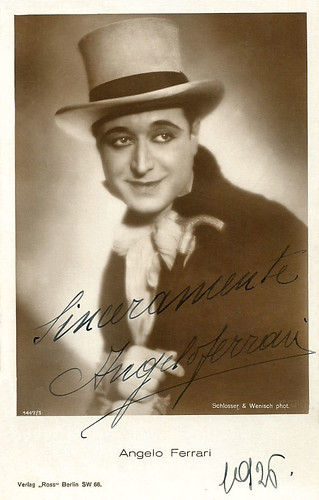
German postcard by Ross Verlag, no. 1447/1, 1926-1928. Photo: Schlosser & Wenisch. Signed: 'Sinceramente [Sincerely], Angelo Ferrari. 1926.'
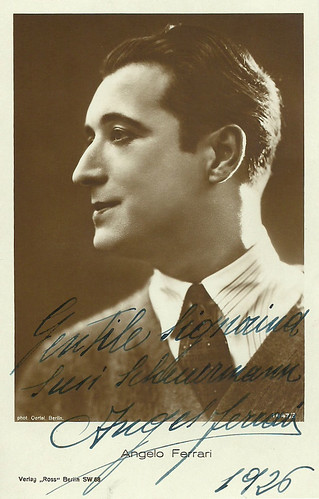
German postcard by Ross Verlag, no. 1447/3, 1926-1928. Photo: Oertel, Berlin. Signed: 'Gentile signorina Susi Schuurmann, Angelo Ferrari. 1926.'

German postcard by Ross Verlag, no. 75/5. Photo: A. Schmoll, Berlin / Henny Porten-Froehlich Produktion. Henny Porten and Angelo Ferrari in Meine Tante - deine Tante (Carl Froehlich, 1927).
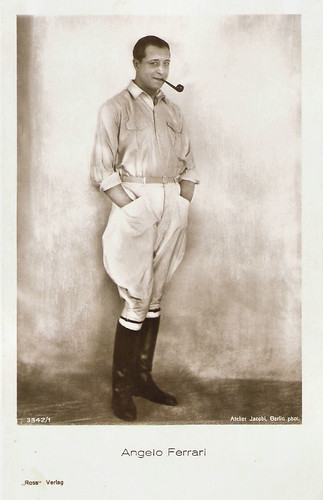
German postcard by Ross Verlag, no. 3342/1, 1928-1929. Photo: Atelier Jacobi, Berlin.
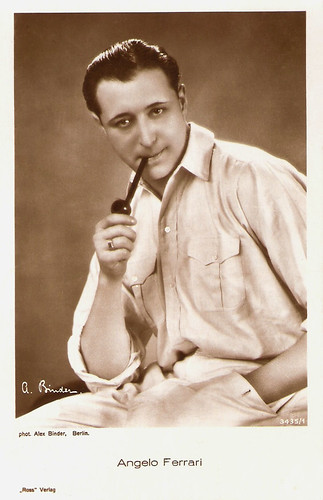
German postcard by Ross Verlag, no. 3435/1, 1928-1929. Photo: Alex Binder, Berlin.
Angelo Ferrari was born in Fara Gera d’Adda in Lombardia, Italy in 1897. In 1913 and 1914, the young Ferrari became the roll skate champion in Italy.
Thomas Staedeli at Cyranos: "Ferrari was spotted by the actress Diana Karenne". She provided the role of a prince for him in the silent film Sofia di Kravonia (Ernesto Maria Pasquali, 1916).
In the late 1910s, he continued with Italian silent films like La serata d'onore di Buffalo/The Gala Night for Buffalo (Carlo Campogalliani, 1916) and Il veliero della morte/The Veil of Death (Carlo Campogalliani, 1917). These films were all produced by the pioneering production company Pasquali Film.
After doing military service between 1916 and 1918, Ferrari worked with well-known director Augusto Genina on I tre sentimentali/The Three Sentimentals (1920), L'incatenata/The Chained Woman (1921) and Un punto nero/The Black Point (1922). Ferrari starred with diva Francesca Bertini in the drama La donna nuda/The Naked Woman (1922), based on a play by Henry Bataille. The film was directed by Roberto Roberti – Sergio Leone’s father,
With another Italian diva, Rina De Liguoro, he appeared in Savitri Satyavan (Giorgio Mannini, 1923). This was the first international co-production of India. The love-is-stronger-than-death story sees Savitri (De Liguoro), the daughter of King Ashwapati and a goddess, fall for Satyavan (Ferrari) who is destined to die within a year. He is killed by a tree and his soul is gathered by the god Yama (Gianna Terribili-Gonzales) but he returns to life and there is a happy ending for the lovers. Some nudity and other 'erotic' images were removed in India to satisfy the censors.
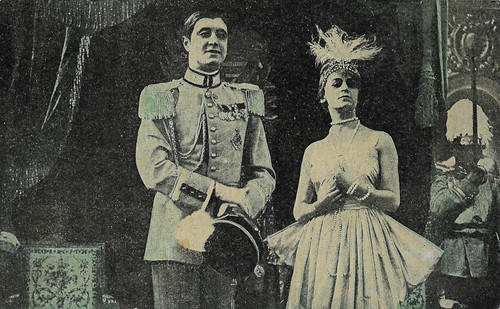
Spanish collectors card by Chocolate Imperiale, no. 4 out of 6 cards. Photo: Pasquali / Vay Film / J. Verdaguer / Prod. Armando Vay, Milano. Diana Karenne and Diana Karenne in Sofia di Kravonia (Ernesto Maria Pasquali, 1916), based on the book by Anthony Hope.

Italian postcard by G.B. Falci, Milano, no. 107. Photo: La Fotominio. Publicity still for La donna nuda/The Naked Woman (Roberto Roberti, 1922) with Francesca Bertini.
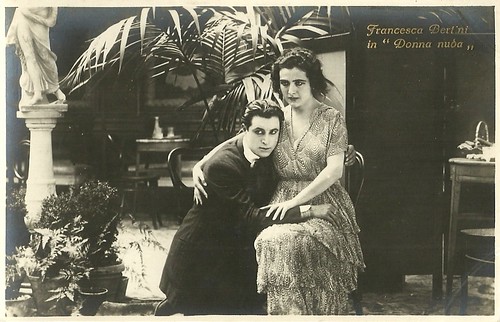
Italian postcard by G.B. Falci, Milano, no. 115. Photo: La Fotominio. Publicity still for La donna nuda/The Naked Woman (Roberto Roberti, 1922) with Francesca Bertini.

Italian postcard. Photo: UCI. Publicity still for the Franco-Italian historical film Cirano di Bergerac/Cyrano de Bergerac (Augusto Genina, 1923), based on Edmond Rostand's famous play Cyrano de Bergerac. Caption: the nice phrases of Christian which he learned from Cyrano have conquered and seduced Roxane. Linda Moglia played Roxanne.

Italian postcard by G.B. Falci, Milano. Rina de Liguoro and Angelo Ferrari in Savitri Satyavan (Giorgio Mannini, 1923), India's first international co-production.
Angelo Ferrari appeared with Geneviève Félix in the French production L'engrenage/The Gear (Maurice Kéroul, Max Reichmann, 1923) before gaining a foothold in the German film business.
His breakthrough role in Germany was as an elegant count in the drama Die grüne Manuela/The Green Manuela (Ewald André Dupont, 1923). The film's plot bears several similarities to 'Carmen'. Lucie Labass played a gypsy dancer, who becomes involved with Spanish smugglers. It was the first time director Dupont worked with the cinematographer Werner Brandes and the art director Alfred Junge who were to become important collaborators with him.
In the silent German cinema, Ferrari acted in successful films like Prater (Peter Paul Felner, 1924) with Henny Porten, Die Motorbraut/The Motor Bride (Richard Eichberg, 1925) with Lee Parry and the Kammerspiel Eifersucht/Jealousy (Karl Grune, 1925) opposite Lya de Putti.
He returned to Italy for another hit, Cirano di Bergerac/Cyrano de Bergerac (Augusto Genina, 1925), a film version of Edmond Rostand's famous play. He played the handsome Christian, who is eager to declare his love for the fair Roxanne (Linda Moglia), but he doesn't have the gift for words that Cyrano (Pierre Magnier) does.
In Germany, he then appeared in dozens of films including Rosen aus dem Süden/Roses From the South (Carl Froelich, 1926) opposite Henny Porten, Orientexpress/Orient Express (Wilhelm Thiele, 1927 with Lil Dagover, and the comedy Kopf hoch, Charly!/Heads Up, Charley (Willi Wolff, 1927) with Marlene Dietrich in a supporting role.
Later followed Die Sünderin/The Sinner (Mario Bonnard, 1927) featuring Elisabeth Pinajeff, the German-Italian drama Villa Falconieri (Richard Oswald, 1928) with Maria Jacobini, and the war drama Richthofen (Peter Joseph, 1929). In his German films, Ferrari often played roles such as an officer, a marquis or a prince.

German postcard by Ross Verlag, no. 694/6, 1919-1924. Photo: Westi. Henny Porten and Angelo Ferrari in Pratertraum/Prater. Die Erlebnisse zweier Nähmädchen (Peter Paul Felner, 1924).
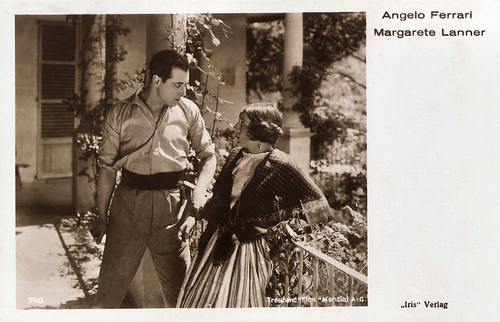
Austrian postcard by Iris Verlag, no. 740. Photo: Treuhand-Film / Mondial A.G. Publicity still for In Treue stark/In Faithful Strong (Heinrich Brandt, 1926) with Margarete Lanner.

Italian postcard, no. 338. Photo: S.A. Stefano Pittaluga. Francesca Bertini and Angelo Ferrari in Mein Leben für das Deine/Odette (Luitz-Morat, 1928), based on Victorien Sardou's play 'Odette', and released in Italy under the same title. Bertini had already played in 1916 in an Italian version of Odette and would do it again in the sound era in a French version of Odette (1935).
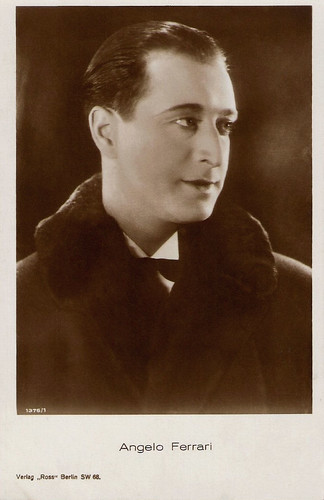
German postcard by Ross Verlag, no. 1376/1, 1927-1928.
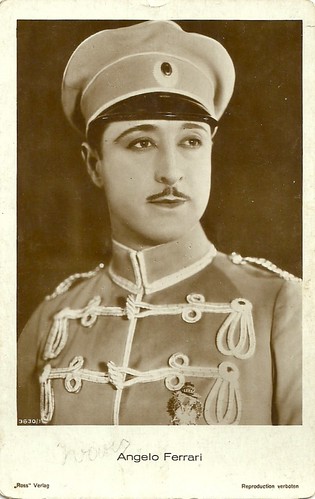
German postcard by Ross Verlag, no. 3630/1, 1928-1929.
Angelo Ferrari’s first sound film was La donna di una notte/The Woman of One Night (Marcel L’Herbier, 1930) featuring the diva of the silent Italian cinema Francesca Bertini. It was an alternate language version of La femme d'une nuit (Marcel L’Herbier, 1930), also starring Bertini.
Because La donna di una notte was edited without his consent, director L'Herbier asked for his name to be removed from the credits. It was still released in Rome and Milan for Christmas of 1931 with his name still appearing.
In the age of the talkies, Ferrari continued to play in well-known German pictures like Barcarole (Gerhard Lamprecht, 1935), Fridericus (Johannes Meyer, 1936), Der Mann der Sherlock Holmes War/The Man Who Was Sherlock Holmes (Karl Hartl, 1937) starring Hans Albers and Heinz Rühmann, and Tango Notturno (Fritz Kirchhoff, 1937) featuring Pola Negri.
But his parts had become smaller because of his lack of the German language. During the 1940s, Ferrari appeared in more than 50 German films, mostly in small, sometimes even uncredited parts. Some of his films were finished and released after the end of the war. The comedy Verlobte Leute/Engaged People, directed by Karl Anton and starring Axel von Ambesser, was filmed in 1945 but had its premiere in 1950 as Das Dementi in East Germany.
Angelo Ferrari was already five years dead by then. After a stroke, he died in Niederlehme, Germany in 1945, briefly before the end of World War II. He was 47.
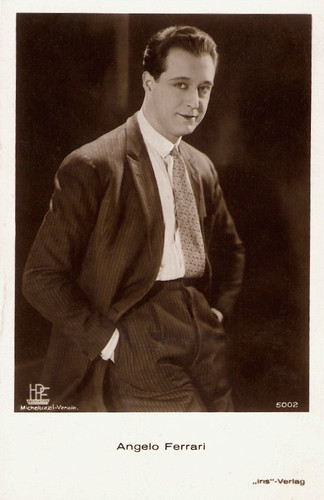
Austrian postcard by Iris-Verlag, no. 5002. Photo: HPF / Micheluzzi-Verleih.
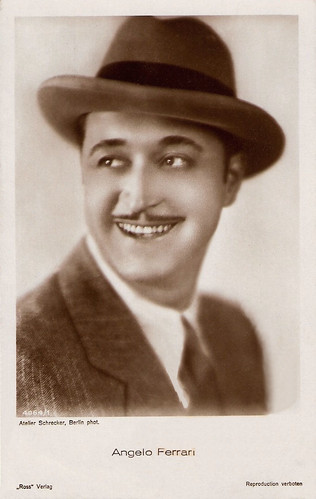
German postcard by Ross Verlag, no. 4064/1, 1929-1930. Photo: Atelier Schrecker, Berlin.
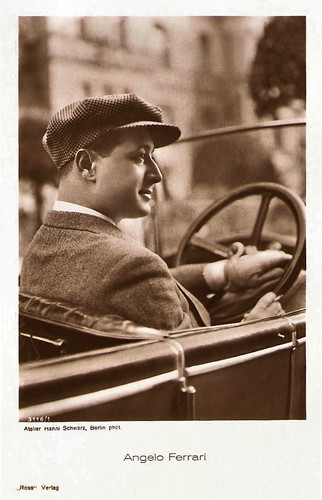
German postcard by Ross Verlag, no. 3116/1, 1928-1929. Photo: Atelier Hanni Schwarz.
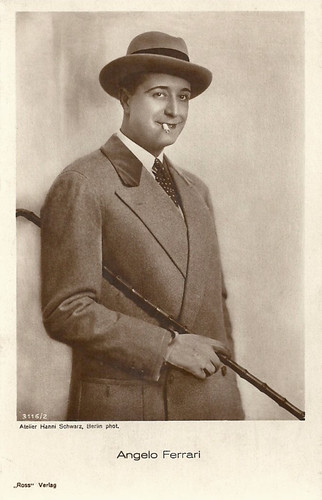
German postcard by Ross Verlag, no. 3116/2, 1928-1929. Photo: Atelier Hanni Schwarz, Berlin.
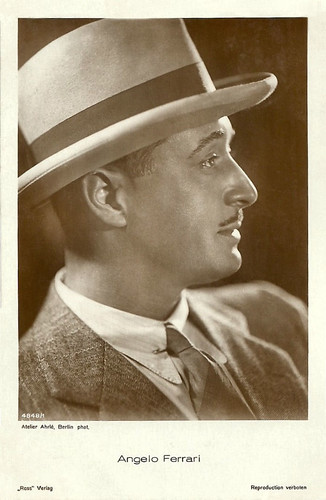
German postcard by Ross Verlag, no. 4848/1, 1929-1930. Photo: Atelier Ahrlé, Berlin.
Sources: Thomas Staedeli (Cyranos), Janiss Garza (AllMovie), Wikipedia (English and German) and IMDb.
This post was last updated on 9 March 2024.

German postcard by Ross Verlag, no. 1447/1, 1926-1928. Photo: Schlosser & Wenisch. Signed: 'Sinceramente [Sincerely], Angelo Ferrari. 1926.'

German postcard by Ross Verlag, no. 1447/3, 1926-1928. Photo: Oertel, Berlin. Signed: 'Gentile signorina Susi Schuurmann, Angelo Ferrari. 1926.'

German postcard by Ross Verlag, no. 75/5. Photo: A. Schmoll, Berlin / Henny Porten-Froehlich Produktion. Henny Porten and Angelo Ferrari in Meine Tante - deine Tante (Carl Froehlich, 1927).

German postcard by Ross Verlag, no. 3342/1, 1928-1929. Photo: Atelier Jacobi, Berlin.

German postcard by Ross Verlag, no. 3435/1, 1928-1929. Photo: Alex Binder, Berlin.
Love-is-stronger-than-death story
Angelo Ferrari was born in Fara Gera d’Adda in Lombardia, Italy in 1897. In 1913 and 1914, the young Ferrari became the roll skate champion in Italy.
Thomas Staedeli at Cyranos: "Ferrari was spotted by the actress Diana Karenne". She provided the role of a prince for him in the silent film Sofia di Kravonia (Ernesto Maria Pasquali, 1916).
In the late 1910s, he continued with Italian silent films like La serata d'onore di Buffalo/The Gala Night for Buffalo (Carlo Campogalliani, 1916) and Il veliero della morte/The Veil of Death (Carlo Campogalliani, 1917). These films were all produced by the pioneering production company Pasquali Film.
After doing military service between 1916 and 1918, Ferrari worked with well-known director Augusto Genina on I tre sentimentali/The Three Sentimentals (1920), L'incatenata/The Chained Woman (1921) and Un punto nero/The Black Point (1922). Ferrari starred with diva Francesca Bertini in the drama La donna nuda/The Naked Woman (1922), based on a play by Henry Bataille. The film was directed by Roberto Roberti – Sergio Leone’s father,
With another Italian diva, Rina De Liguoro, he appeared in Savitri Satyavan (Giorgio Mannini, 1923). This was the first international co-production of India. The love-is-stronger-than-death story sees Savitri (De Liguoro), the daughter of King Ashwapati and a goddess, fall for Satyavan (Ferrari) who is destined to die within a year. He is killed by a tree and his soul is gathered by the god Yama (Gianna Terribili-Gonzales) but he returns to life and there is a happy ending for the lovers. Some nudity and other 'erotic' images were removed in India to satisfy the censors.

Spanish collectors card by Chocolate Imperiale, no. 4 out of 6 cards. Photo: Pasquali / Vay Film / J. Verdaguer / Prod. Armando Vay, Milano. Diana Karenne and Diana Karenne in Sofia di Kravonia (Ernesto Maria Pasquali, 1916), based on the book by Anthony Hope.

Italian postcard by G.B. Falci, Milano, no. 107. Photo: La Fotominio. Publicity still for La donna nuda/The Naked Woman (Roberto Roberti, 1922) with Francesca Bertini.

Italian postcard by G.B. Falci, Milano, no. 115. Photo: La Fotominio. Publicity still for La donna nuda/The Naked Woman (Roberto Roberti, 1922) with Francesca Bertini.

Italian postcard. Photo: UCI. Publicity still for the Franco-Italian historical film Cirano di Bergerac/Cyrano de Bergerac (Augusto Genina, 1923), based on Edmond Rostand's famous play Cyrano de Bergerac. Caption: the nice phrases of Christian which he learned from Cyrano have conquered and seduced Roxane. Linda Moglia played Roxanne.

Italian postcard by G.B. Falci, Milano. Rina de Liguoro and Angelo Ferrari in Savitri Satyavan (Giorgio Mannini, 1923), India's first international co-production.
France, Germany, Italy
Angelo Ferrari appeared with Geneviève Félix in the French production L'engrenage/The Gear (Maurice Kéroul, Max Reichmann, 1923) before gaining a foothold in the German film business.
His breakthrough role in Germany was as an elegant count in the drama Die grüne Manuela/The Green Manuela (Ewald André Dupont, 1923). The film's plot bears several similarities to 'Carmen'. Lucie Labass played a gypsy dancer, who becomes involved with Spanish smugglers. It was the first time director Dupont worked with the cinematographer Werner Brandes and the art director Alfred Junge who were to become important collaborators with him.
In the silent German cinema, Ferrari acted in successful films like Prater (Peter Paul Felner, 1924) with Henny Porten, Die Motorbraut/The Motor Bride (Richard Eichberg, 1925) with Lee Parry and the Kammerspiel Eifersucht/Jealousy (Karl Grune, 1925) opposite Lya de Putti.
He returned to Italy for another hit, Cirano di Bergerac/Cyrano de Bergerac (Augusto Genina, 1925), a film version of Edmond Rostand's famous play. He played the handsome Christian, who is eager to declare his love for the fair Roxanne (Linda Moglia), but he doesn't have the gift for words that Cyrano (Pierre Magnier) does.
In Germany, he then appeared in dozens of films including Rosen aus dem Süden/Roses From the South (Carl Froelich, 1926) opposite Henny Porten, Orientexpress/Orient Express (Wilhelm Thiele, 1927 with Lil Dagover, and the comedy Kopf hoch, Charly!/Heads Up, Charley (Willi Wolff, 1927) with Marlene Dietrich in a supporting role.
Later followed Die Sünderin/The Sinner (Mario Bonnard, 1927) featuring Elisabeth Pinajeff, the German-Italian drama Villa Falconieri (Richard Oswald, 1928) with Maria Jacobini, and the war drama Richthofen (Peter Joseph, 1929). In his German films, Ferrari often played roles such as an officer, a marquis or a prince.

German postcard by Ross Verlag, no. 694/6, 1919-1924. Photo: Westi. Henny Porten and Angelo Ferrari in Pratertraum/Prater. Die Erlebnisse zweier Nähmädchen (Peter Paul Felner, 1924).

Austrian postcard by Iris Verlag, no. 740. Photo: Treuhand-Film / Mondial A.G. Publicity still for In Treue stark/In Faithful Strong (Heinrich Brandt, 1926) with Margarete Lanner.

Italian postcard, no. 338. Photo: S.A. Stefano Pittaluga. Francesca Bertini and Angelo Ferrari in Mein Leben für das Deine/Odette (Luitz-Morat, 1928), based on Victorien Sardou's play 'Odette', and released in Italy under the same title. Bertini had already played in 1916 in an Italian version of Odette and would do it again in the sound era in a French version of Odette (1935).

German postcard by Ross Verlag, no. 1376/1, 1927-1928.

German postcard by Ross Verlag, no. 3630/1, 1928-1929.
The age of the talkies
Angelo Ferrari’s first sound film was La donna di una notte/The Woman of One Night (Marcel L’Herbier, 1930) featuring the diva of the silent Italian cinema Francesca Bertini. It was an alternate language version of La femme d'une nuit (Marcel L’Herbier, 1930), also starring Bertini.
Because La donna di una notte was edited without his consent, director L'Herbier asked for his name to be removed from the credits. It was still released in Rome and Milan for Christmas of 1931 with his name still appearing.
In the age of the talkies, Ferrari continued to play in well-known German pictures like Barcarole (Gerhard Lamprecht, 1935), Fridericus (Johannes Meyer, 1936), Der Mann der Sherlock Holmes War/The Man Who Was Sherlock Holmes (Karl Hartl, 1937) starring Hans Albers and Heinz Rühmann, and Tango Notturno (Fritz Kirchhoff, 1937) featuring Pola Negri.
But his parts had become smaller because of his lack of the German language. During the 1940s, Ferrari appeared in more than 50 German films, mostly in small, sometimes even uncredited parts. Some of his films were finished and released after the end of the war. The comedy Verlobte Leute/Engaged People, directed by Karl Anton and starring Axel von Ambesser, was filmed in 1945 but had its premiere in 1950 as Das Dementi in East Germany.
Angelo Ferrari was already five years dead by then. After a stroke, he died in Niederlehme, Germany in 1945, briefly before the end of World War II. He was 47.

Austrian postcard by Iris-Verlag, no. 5002. Photo: HPF / Micheluzzi-Verleih.

German postcard by Ross Verlag, no. 4064/1, 1929-1930. Photo: Atelier Schrecker, Berlin.

German postcard by Ross Verlag, no. 3116/1, 1928-1929. Photo: Atelier Hanni Schwarz.

German postcard by Ross Verlag, no. 3116/2, 1928-1929. Photo: Atelier Hanni Schwarz, Berlin.

German postcard by Ross Verlag, no. 4848/1, 1929-1930. Photo: Atelier Ahrlé, Berlin.
Sources: Thomas Staedeli (Cyranos), Janiss Garza (AllMovie), Wikipedia (English and German) and IMDb.
This post was last updated on 9 March 2024.
very great blog you have.
ReplyDeleteIgor
Thanks. I've also visited your bikini blog. Fun. We have a lot of vintage pin-up cards on our Flickr-site (Truus, Bob & Jan Too! - http://www.flickr.com/photos/truusbobjantoo/sets/72157608728226857/). You can use the bikini cards for your blog if you like. Just give us a credit.
ReplyDeleteThe Maria Perschy postcard is also in my collection, so I'll feature her too on EFSP soon.